Integrated Boiler House Control Part 3 - The "Wet Side"
The Boiler, the control of which can be broken down into two distinct sections.
The Dry Side
‘Combustion’, automatic balancing of the air/fuel mixture and matching heat input to the varying steam load, referred to as turndown’ is a subject in its own right and best left to the experts, the Dunphy’s and Saacke’s of this world.
The Wet Side
Water, in particular, the volume, level and condition, is of concern and if we don’t get the control correct then it can be as detrimental to the overall efficiency of steam generation as a badly adjusted fuel/air mixture.
It is fair to say that the ‘Combustion side’ of the boiler, ‘The Dry Side’, receives rather a lot of attention due to the impact on the environment and the cost of fuel. But little or no attention is given to the ‘Wet Side’ except for pump cavitation, water level and surface blowdown (TDS) control of the boiler(s). And the alchemy surrounding feed and boiler water chemistry is rarely discussed. This despite the Combustion Engineering Association (CEA) stating that 95% of boiler failures are related to poor water treatment.
Best Practice suggests that:-
To prevent feed pump cavitation it suggests that feedwater temperature is controlled between 80°C to 85°C. To protect the boiler we install ‘Self-Monitoring’ low water alarms, when activated, shutting off the fuel supply and the best way of adding the correct level of water treatment is to drip feed the chemicals directly into the feedtank. Then To prevent carryover we install a surface (TDS) blowdown control system to control the salt content at manageable limits and operate the bottom blowdown valve once a shift to remove any sludge all will be well.
That’s best practice and providing that the combustion process is operating correctly then: - The ‘Cost of Steam’ will be what it is.
Controls 4 Steam don’t believe that that is ‘Best Practice’ and that 50 years after man first set foot on the moon technology has improved sufficiently enough so that we can do better.
Pump Cavitation
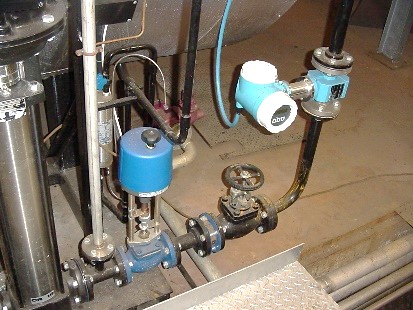 Maintaining a feedtank temperature at 80°C to 85°C because of the threat of cavitation is detrimental to the efficient operation of the boiler plant. At 80°C, to control the oxygen content you need 3 times the amount of sodium sulphite as you do at 95°C. Sodium sulphite raises the salt content of the boiler water increasing blowdown. Which results in an increase in chemical usage and cost whilst increasing blowdown and energy losses. A double whammy.
Maintaining a feedtank temperature at 80°C to 85°C because of the threat of cavitation is detrimental to the efficient operation of the boiler plant. At 80°C, to control the oxygen content you need 3 times the amount of sodium sulphite as you do at 95°C. Sodium sulphite raises the salt content of the boiler water increasing blowdown. Which results in an increase in chemical usage and cost whilst increasing blowdown and energy losses. A double whammy.
Cavitation occurs when the Nett Positive Suction Head (NPSH) is lower than the boiling point of the liquid at the inlet to the pump. Lowering the feedwater temperature lowers its boiling point. At 85°C the vaporisation pressure of water is -0.41 BarG and therefore as long as the pressure at the inlet to the pump is greater than that pressure then cavitation will not occur.
Let’s be clear, in the majority of cases, it is not the pump that causes cavitation but the installation. The two most common causes are inlet pipework undersized and the feed pump oversized. Both conditions will cause cavitation and significantly increase the pump electrical operating costs. Simply installing a compound pressure gauge at the pump inlet will give you the answer every time the pump switches on.
With the pump off the gauge will show you the static pressure at the inlet to the pump and if the pressure falls when the pump switches on then the pump is trying to suck the water from the feedtank. Either the supply pipe is undersized or the pump is oversized.
The rule of thumb is that the feedwater supply pipe should be at least two pipe sizes larger than the inlet of the pump. Obviously if the feedtank is remote from the feed pump, as is generally the case with boiler mounted pumps then you should consider increasing the pipe size. The pressure gauge will give you the answer as soon as you switch the pump on. If you are having problems with cavitation you’d best speak to the manufacturer. Xylem and Grundfos are most common on UK boilers both of which would gladly assist in guiding you in the right direction.
Boiler Water Safety and Alarms
The boiler safety is reliant on a pressure switch to switch off the burner, safety valves set at a level that will prevent the boiler over pressurising and two independent, self-monitoring low water alarms, shutting off the fuel supply on low water. BG01 arrangement 3 for 72hrs attendance also has high, high level lockout controls, condensate monitoring system and the ability to integrate into BMS systems for remote monitoring and alarm notification.
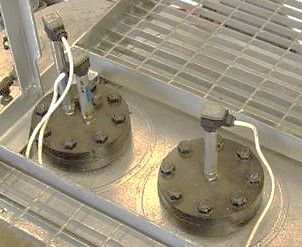
Once you add automated bottom blowdown and automatic TDS control you are free to operate the boiler unmanned for 72 hours.
Is this the best we can do for unattended sites?
The lack of water poses one of the highest risks of a dangerous occurrence and therefore should come high on the list of any Risk Assessment or Hazop especially with regard to unattended sites.
Whilst Controls 4 Steam haven’t read many boiler house risk assessments, we are willing to bet that not many if any raise the subject of water monitoring and the need for additional safety measures to mitigate 72 hour unattended boiler operation. Measures that would have been part and parcel of boilerman’s daily routine.
Quite simply all that is required is to monitor the feedwater flowrate when the boiler level control system calls for water. With a water meter installed upstream of the feed pump its output can be monitored and compared to the boiler water level. If the meter output doesn’t increase when the level controller output increases then you have a problem with the water supply and at that moment an alarm should be raised.
If you want to reduce the risk further then look at the feedtank. Boiler feedtanks are sized on a nominal 1 hour water storage and it is the feedtank that will first register a problem with the cold make-up water supply.
By installing both a cold water make-up and a hot feedwater meter and monitoring their outputs caters for both water and feed pump failure before the boiler registers that it is short of water.
Providing the ‘Pre-emptive’ alarms gives engineers more time to respond.
Feedwater Chemical Dosing
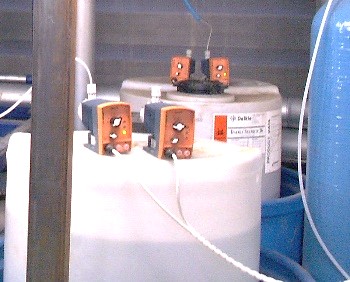 The present method of dosing feedwater chemicals has its origins when the chemicals were changed from powder form to liquid. At that time, some 50 or 60 years ago, adding chemicals was a manual task and it was left up to the chemical companies to devise a better, safer way of adding the chemicals.
The present method of dosing feedwater chemicals has its origins when the chemicals were changed from powder form to liquid. At that time, some 50 or 60 years ago, adding chemicals was a manual task and it was left up to the chemical companies to devise a better, safer way of adding the chemicals.
The system relied on the Boilerman taking 3 or 4 samples a shift and adjusting the pump settings according to the result. In the late 80’s, 24 hour unattended operation was allowed and with it the requirement to sample boiler water was reduced to once per day to accommodate the lack of manning without fully understanding the ramifications of reducing the sample rate from 12 to 1 had on the efficient operation of the boiler plant.
Now that the industry standard allows for 72 hour unattended boiler operation there are those that want to change the rules again to one sample per visit. This despite the fact that the Combustion Engineering Association (CEA) clearly state that 95% of boiler failures are related to poor feedwater treatment.
Let’s be clear it is not the chemicals that are the cause of boiler failure but the way in which the chemicals are added.
There are two basic rules in controls: -
- You can’t control what you can’t measure
- Without ‘Feedback’ there is no control
When the dosing pumps were first introduced the measurement and feedback were carried out by the Boilerman as part of his daily duties.
Now that the Boilerman is out of the equation then there are too many unknowns and the present system is not fit for purpose.
Technology has moved on over the last 50 years, Wi-Fi, Broadband, smart phones, electric cars etc., but not controlling the dosing of chemicals into a boiler which we now leave unattended.
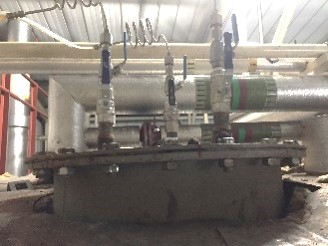 In the absence of a suitable control system then apparently ‘Best Practice’ is based around drip feeding chemicals direct to the feedtank with daily manual tests to ensure the parameters are met. Which are to ensure that there is no free oxygen in the boiler water, boiler pH is maintained between 10.5pH and 12.0pH and the dissolved salt level within the boiler is limited to between 3200ppm & 3500ppm.
In the absence of a suitable control system then apparently ‘Best Practice’ is based around drip feeding chemicals direct to the feedtank with daily manual tests to ensure the parameters are met. Which are to ensure that there is no free oxygen in the boiler water, boiler pH is maintained between 10.5pH and 12.0pH and the dissolved salt level within the boiler is limited to between 3200ppm & 3500ppm.
The most common oxygen scavenging chemical in use on UK land based boilers is sodium sulphite. The neutralisation ratio of sulphite is 10:1 so with a nominal feedwater temperature of 80°C & the mg/O2 content of 3.1 requires 31mg/l of sulphite. The main problem with drip feeding sulphite at a constant rate is it takes no account of the actual water temperature or flowrate which are the two main criteria for accurate chemical dosing. With atmospheric feedtanks there is also the problem of re-entrainment of oxygen.
When the cold water make-up is on/off and connected to an atmospheric deaerator how do you take account of the sudden drop in feedwater temperature when the cold water switches on and the feedwater outlet temperature drops by 10°C.
With caustic control for boiler pH it is a little simpler maintaining the pH on a one boiler site because the safe range is between 10.5pH & 12.0pH. It’s referred to as a ‘Buffer’ of ‘Reserve’. But what does that mean? If we use a 10,000kg/hr boiler as an example the water content will be approximately 16600 litres (depending on manufacturer) to maintain the pH @ 10.5 requires 1.4litres of caustic but at 12.0pH that rises to 44.3 litres that is 31.6 times the amount of caustic required. So maintaining a ’Buffer’ shouldn’t be a problem.
Apart from the fact that the higher the pH the higher is the underlying dissolved salts level and additional cost of the chemicals. Both resulting in increased blowdown and energy loss.
To ensure that we adequately treat the feedwater under all conditions it is natural to set the dosing rate higher than is necessary. So on one hand you have increased chemical costs due to over dosing and on the other you have increased blowdown with the attendant increase in energy and water losses due to over dosing the chemicals in the first place. To reduce the wasted energy blowdown heat recovery systems are available capable of recovering 90% of the wasted heat but at what cost? It is not the chemicals that are the problem but the way in which those chemicals are added to the feedwater.
Help is at hand. Aquanet International Ltd, Newbury resolved the conundrum for the marine industry some 30 years ago and the AQ300 control system was born.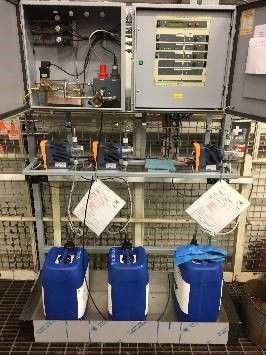 Designed as a standalone control system with a capability to take 5 independent samples and drive 5 separate dosing pumps. Dosing oxygen scavenging chemical based on actual feedwater temperature and flowrate, both of which vary throughout the course of each day. Individually controlling the pH & TDS of up to 3 boilers whilst at the same time monitoring feedwater and returning condensate. The system comes complete with software for remote monitoring and connectivity to BMS system. Monitoring and controlling 24hr/day 7 days/week.
Designed as a standalone control system with a capability to take 5 independent samples and drive 5 separate dosing pumps. Dosing oxygen scavenging chemical based on actual feedwater temperature and flowrate, both of which vary throughout the course of each day. Individually controlling the pH & TDS of up to 3 boilers whilst at the same time monitoring feedwater and returning condensate. The system comes complete with software for remote monitoring and connectivity to BMS system. Monitoring and controlling 24hr/day 7 days/week.
Adding the control system will reduce the cost of steam.
As an example let us take a 10,000kg/hr boiler, chemicals dosed direct to feedtank.
Feedwater TDS including chemicals 225ppm boiler TDS 3200 boiler pH 11.5
Surface Blowdown rate = 8.98%
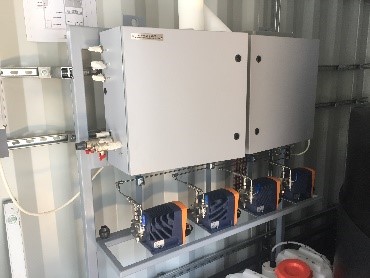 With Aquanet in control Feedtank temperature 95°C, cold make-up 120TDS, 80% condensate return, boiler pH 10.5 Surface blowdown = 2.00%
With Aquanet in control Feedtank temperature 95°C, cold make-up 120TDS, 80% condensate return, boiler pH 10.5 Surface blowdown = 2.00%
Saving of 6.89%, given 1% reduction equates to 0.2% fuel usage then fuel saving is 1.38%.
Annual Fuel Saving
10T/hr x 24hrs x 365 x £20/T = £1,752,000.00 1.38% of which is £24,177.60/annum
Water Saving 10T/hr x 6.89% x 24 x 365 x £2.30p = £13,881.97
Total saving per Annum = £24177.60 + £13881.97 = £38059.57
Annual savings achievable simply by installing a control system to replace the process of drip feeding chemicals into the feedtank and blowing the excess TDS down the drain.
Integrated Boiler Control